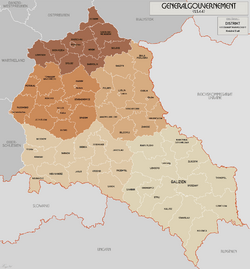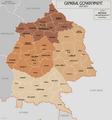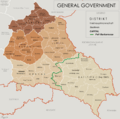General Government facts for kids
General Government (GG, Polish: Generalne Gubernatorstwo) is a term who refers to a region in central Poland. This region, after its annexation from the Nazi Germany in 1939, was declared semi-autonomous with local civil and military administration. Unlike Vidkun Quisling's Norway, it wasn't a puppet state. The local authorities were staffed with Germans faithful to National Socialism.
The creation
Germany invaded in Poland on September 1, 1939, triggering the start of World War II. Germany won Poland in just 18 days. In September 18, the Soviet Union, signatory party of the Ribbentrop-Molotov Pact, also invades Poland. Thus, Poland is divided in three parts:
- The western part who was annexed directly in the Greater German Reich as Gau Wartheland.
- The eastern part was annexed by the Soviet Union. Unlike Germany, much of the occupied Polish territory remained in the Soviet Union after the war.
- The central part is remaining occupied by Germany. According to a Hitler's decree of October 12, 1939, a General Government is created.
At first, General Government was composed of four Polish voivodeships: Warsaw, Radom, Lublin and Kraków. In August 1941, the General Government was enlarged, incorporating Galicia which was detached from the Soviet Union. Kraków was the capital.
Images for kids
-
Hans Frank, head of the General Government, at a police parade in Kraków during the German occupation of Poland
-
German-Soviet border drawn in the aftermath of the Nazi-Soviet invasion of Poland, signed in Moscow by Stalin and Ribbentrop during the Second Ribbentrop-Molotov Pact known as the Frontier Treaty of September 28, 1939
-
Hans Frank with district administrators in 1942 – from left: Ernst Kundt, Ludwig Fischer, Hans Frank, Otto Wächter, Ernst Zörner, Richard Wendler
-
Administrative map of the General Government, July 1940 (before Barbarossa)
-
German announcement of the execution of 9 Polish peasants for unfurnished contingents (quotas). Signed by the governor of Lublin district on 25 November 1941
-
Announcement by the Chief of SS and Police 5.09.1942—Death penalty for Poles offering any help to Jews
-
Warsaw Ghetto Uprising, April 1943: Jews being held at gunpoint by SS troops (from a report written by Jürgen Stroop for Heinrich Himmler)
-
Warsaw Uprising: Polish soldiers in action, August 1, 1944
-
Portrait of a Young Man by Raphael, stolen at the behest of Hans Frank in 1939 and never returned; one of over 40,000 works of art robbed from Polish collections
See also
 In Spanish: Gobierno General para niños
In Spanish: Gobierno General para niños























